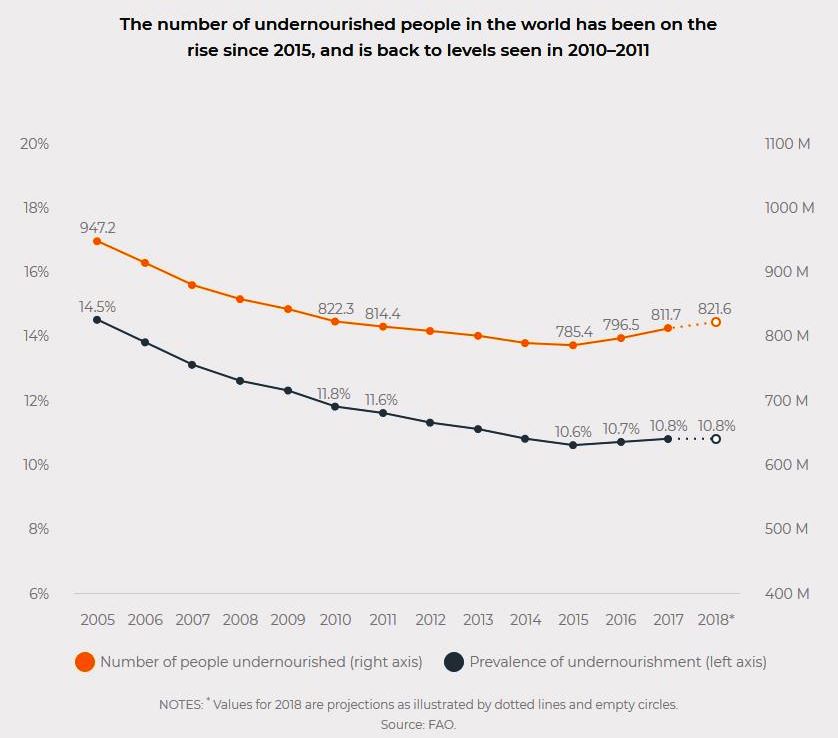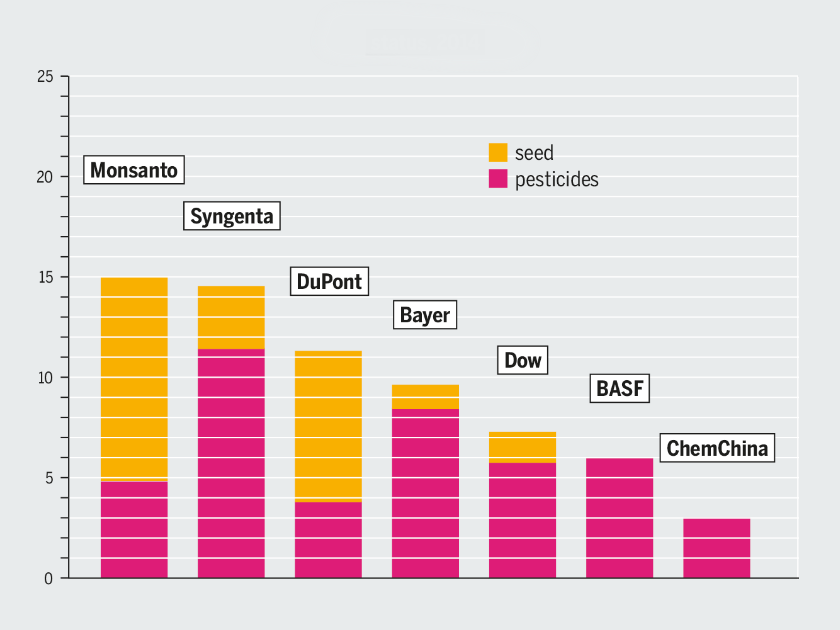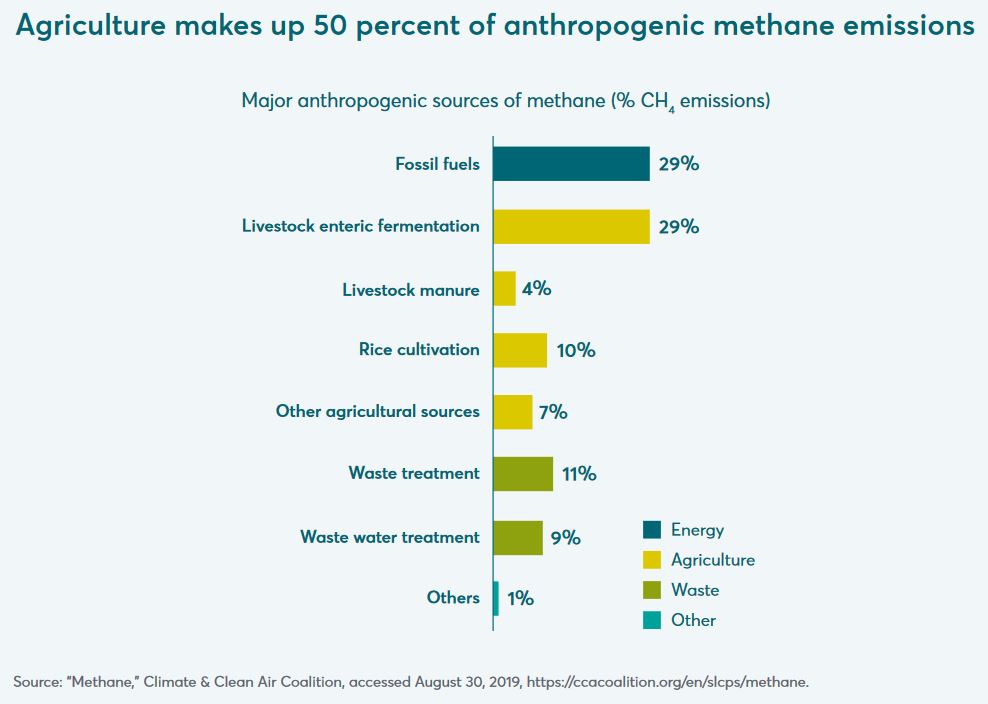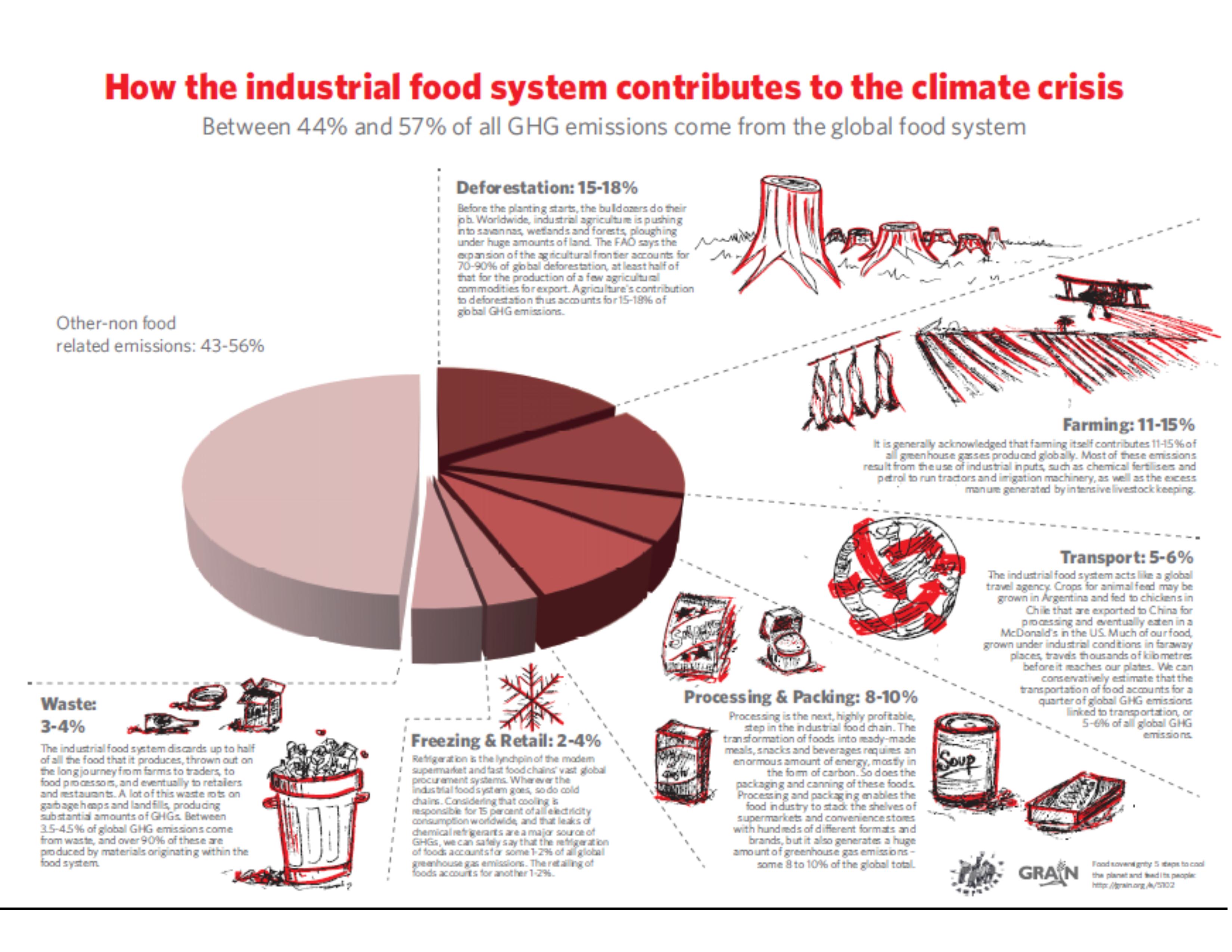By Manlio Masucci – Navdanya International, 2 March 2020
Victims and culprits: the way we produce our food is responsible for a large share of the climate altering emissions
Speaking of climate change, sometimes it feels like we are witnessing a b-series remake of an Alfred Hitchcock movie, where the culprits are disclosed from the very beginning while the rest of the plot carries on describing the circumstances of the crime, almost forgetting that the murderers and their accomplices are still on the loose and in a position to continue to commit crimes.
So, we know that the culprits, or at least some of the main ones responsible for the crimes committed against the planet and all its inhabitants, have long been identified on the basis of solid documentary evidence. We even have their admissions. Yet the prosecution continues to be delayed, leaving the offenders and their accomplices free to pursue their shady business.
As mentioned, the culprits and their accomplices are known to us but it is worth mentioning them. In the dock are the large industrial farms and factory farms that are part of the agribusiness system, the large-scale distribution system, as well as lobbying groups, scientists who are anything but independent, and complacent journalists. And last but not least, those policy makers who ensure the survival of an obsolete and outdated system, by continuing to provide subsidies and tax breaks to the wrong subjects.
What is being contested is, simply put, our food production system, which is responsible in large part for the climate-altering emissions. A system, offshoot of the Green Revolution, which since the 1940s has gradually been imposed as the dominant model with the promise of feeding the world’s growing population. Before going into the reasons why such a production system has caused, and continues to cause considerable damage to the health of the planet and of its inhabitants, it is necessary to point how that promise has been totally disregarded. According to the latest FAO data, the food security of a large part of the world’s population has not been guaranteed at all, with 820 million people in the world still suffering from hunger. The production system has also created new forms of poverty and marginalisation, new health emergencies, loss of food sovereignty and new forms of exploitation, contributing to the malaise of the world’s population.

In short, the pretext, promoted by these same culprits to justify the industrialization and globalization of the production and distribution of our food, does not hold up. The damage was done not while trying, in good faith, to save the world, but rather while trying to inflate the budgets and dividends of corporations in the sector which ensured almost exclusive, hegemonic and monopolistic control of the agri-food market, through aggressive acquisitions, land grabbing, forced displacement of populations, the use of intellectual property, and blatant lobbying operations.
This is the case of the global seed market that, after the very recent round of mergers of the major corporations in the sector, is controlled by more than 60% by just four companies that simultaneously hold 70% of the agrochemical products market, including pesticides and fertilizers. The race for monopolies is literally suffocating the market by imposing the rule of the fittest, dictating production models, grabbing most of public subsidies and in effect widely inhibiting the emergence of alternative and sustainable models. The control over seeds, the first link in our food chain, allows large multinationals to impose their own rules on agricultural production systems. And at the centre of corporate attention are, interestingly enough, resilient traditional varieties, such as those resistant to salt, drought and flooding. Thus insult is added to injury: not only are the culprits freely on the loose, but they are aiming to reorganize themselves to gain space for themselves in the economic model of the future.

From the Agrifood Atlas – Concentration of the biggest agrochemical companies« licence: CC-BY 4.0
Subsidies and tax breaks: citizens’ taxes support a system with negative productivity and strong environmental impacts.
Industrially produced food, transported along the extensive and unsustainable supply chains (where 30% of the product is lost) is harmful in many ways. According to FAO data, one third of the product value is lost in social costs. The global value of food production has been calculated at $2.8 trillion, environmental costs have been calculated at $3 trillion, to which another $2.8 trillion should be added for costs related to the loss of social welfare and conflicts caused by the loss of natural resources such as soil and water. In short, for every euro of food produced we have already spent another 3. These are some of the so-called hidden costs that taxpayers pay.
The industrial agricultural system therefore has a negative productivity, and could not sustain itself without the enormous public subsidies. The health, environmental and societal costs are not taken into account and are treated as externalities that do not affect the final price of products. People all over the world are paying billions in subsidies out of their own pockets and turning them into profits for the companies themselves. The aim of the current system, which we cannot define as a food system but rather an industrial agricultural system, is therefore not to guarantee adequate nutrition and human wellbeing, but to maximise the profits of Big Food.
A global trend, but one that sees Italy once again in the front line. According to a recent report by the Food and Land Use Coalition, the public donates more than 1 million dollars per minute of global agricultural subsidies, many of which are at the root causes of the climate crisis and the ecosystem destruction. The idea is that subsidies are needed to provide cheap food to feed the growing world population. But this is an empty and misleading slogan. The report confirms that the cost of the damages currently caused by agriculture is higher than the value of the food produced. Changing the use of subsidies to instead store carbon in the soil, produce healthier food, and reduce waste is not only a necessity but also a huge opportunity as a real driver of economic development.
If the global situation does not look rosy, what happens in Italy where excesses of zeal often lead our ruling classes to be more realistic than the king? According to an analysis carried out by the Senate’s Impact Assessment Office, based on the data contained in the first Environmental Subsidies Catalogue produced by the Ministry of the Environment, in Italy the system of subsidies is flanked by that of tax concessions for activities that have a major impact on the environment and therefore on climate change. These include nitrogenous fertilizers, mineral water, electricity consumed by households and agricultural and manufacturing companies, methane gas for domestic use, plant protection products including insecticides and herbicides. favorable VAT, exemptions, tax credits are, as analysed in the report, a real godsend for polluters given that almost all environmentally harmful subsidies (more than 97%) are tax discounts (estimated value of 22 billion euros, compared to 19 billion direct subsidies).

So what’s the result of this productive system, from the net money spent by taxpayers to finance it? According to the IPCC, between 25 and 30% of the impacting emissions are caused by the current agri-food system. But this is a cautious calculation. According to other estimates this percentage would be around 50%. A calculation that is not easy considering all the elements that contribute to the total sum: in addition to agriculture and livestock farming, also deforestation practices, transportations, processing and packaging, refrigeration, distribution and waste of the actual food produced must be added to the final sum.
We know who are those responsible for the current environmental disaster, and yet not only do we continue as though nothing is happening, but with our taxpayers’ money we are financing all of their hardware and we are even prepared to pay the costs of the damage as a result of their crimes.
It is not only a matter of production systems but of a holistic vision that aims to evolve our relationship with the earth and with all its species.
The way we produce our food plays a key role in reducing greenhouse gas emissions and climate change mitigation. The dominant industrial food production – characterised by commercial seeds, use of chemicals, high water consumption, energy-intensive giant agricultural equipment and a massive global transport system based on fossil fuels – is very vulnerable to climate change and significantly contributes to this phenomenon. Food processing, packaging, long-distance refrigeration and mass transport infrastructure systems contribute to the use of fossil fuels. Soils treated with chemical fertilizers and emptied of organic matter lose their ability to retain water, making agricultural areas more vulnerable to drought and flooding. Parallel to that, economic globalization policies increase the environmental impacts by employing resource and energy intensive consumption patterns.
We can therefore say that agriculture is one of the most vulnerable human activities to climate change, because it is based on the delicate balance of multiple ecosystem services. At the same time, agriculture can play an important role when it comes to solutions to climate change. It is agroecology in particular that provides the basis for that transition. A multitude of studies, including those of international bodies such as the FAO, recognise that a paradigm shift towards agroecological agriculture is urgent and necessary, and represents a solution to the interconnected crises of our time, not only in the agricultural sector, but also in the economic and social spheres, particularly in the face of climate change.
But how can agroecology help mitigate climate change?
Through a transformative approach, agroecology regenerates soil fertility and other ecological and biological processes in ecosystems, as well as it ensures local communities’ livelihoods by recycling nutrients and allowing the production of significant amounts of food with minimal use of external inputs. Agroecological systems are designed to regenerate functional biodiversity to improve the sustainability of agroecosystems, by providing ecological services, such as biological pest regulation, nutrient cycling, water and soil conservation.
Stability and sustainability are enhanced by the mutually beneficial functions found in nature through biodiversity, with beneficial effects on climate change adaptation and mitigation. For instance, crop diversification techniques developed by traditional farmers, represent an important resilience strategy. Biodiversity of plants, animals and soil micro-organisms is consequently essential to ensure the necessary balance of factors that makes agroecosystems more resilient to climate change.
As Vandana Shiva argues, « biodiversity increases resilience, returning more carbon to the soil, and improving the soil’s ability to withstand drought, flooding and erosion. Less diverse or monoculture-based ecosystems are extremely vulnerable and unsustainable ». Not only do we have the right and the duty to curb the wave of organised criminality against the planet and its inhabitants, but we also have the counter evidence that the agribusiness dictatorship is far from necessary for our survival.
The solutions are within reach but a political breakthrough is needed to boost the transition
Alternatives to the industrial productive system exist and are already locally practiced, with excellent results. These alternatives are based on an agro-ecological approach, the conservation of biodiversity, the promotion of organic farming, the enhancement of short supply chains, tending to the values of fairness and social justice. Even the myth of low productivity, perpetrated by the industry itself, has now been dismissed. According to FAO data, while using 75 percent of the total land, industrial agriculture based on fossil fuel, chemically intensive monocultures produce only 30 percent of the food we eat, while small farms, which use 25 percent of the land, provide 70 percent of the food.
Agro-ecological solutions to climate change are based on a systemic approach, on a deep understanding of the transformation processes of living beings, which involve political, social and economic transformations. Multi-functional and diverse agricultural systems and locally diversified food systems are essential to ensure food security in an era of climate change. A rapid global transition to such systems is imperative both to mitigate climate change and to ensure food security.
As stated in the « Declaration of Small Food Producers and Civil Society Organisations » at the Second International Symposium on Agroecology: « Agroecology cannot be understood as a simple set of production techniques and practices. Agroecology is a lifestyle to our peoples, carried on in harmony with the language of nature. It represents a paradigm shift in the way we deploy social, political, productive and economic relations with our territories, to transform the way we produce and consume food and to restore a socio-cultural reality devastated by industrial food production. Agroecology generates local knowledge, builds social justice, promotes identity and culture and strengthens the economic vitality of rural and urban areas ».
Agroecology can therefore represent a systemic solution, a cornerstone of the necessary paradigm shift in production. Politicians must then admit their mistakes and stop justifying and protecting those responsible for the environmental and social disaster, and instead facilitate the transition through the enhancement of local experiences. The challenge of sustainable development in the 21st century lies precisely in reorienting our agricultural and food systems to make them not only more compatible with the nutritional and health needs of a growing world population, but also environmentally and financially sustainable.
There are many local realities which, pending systemic change, have embarked on the path of transition. In Italy alone, about 70 mayors have decided to curb the bullying of industrial agriculture by tightening the regulations in their municipalities, while the experience of the bio-districts explicitly refers to the agroecological one. The common characteristic of this type of local initiatives is precisely the systemic approach. Agriculture no longer represents a productive practice isolated from the rest of the world, surrounding the fields. By taking care of the soil, aquifers, agricultural production, air and landscape aesthetics, communities are rediscovering the value of aesthetically attractive landscapes, quality catering, the enhancement of local traditions and the preservation of the social fabric. A process of regeneration that can, in turn, feed new circuits of local and sustainable economy, as is the case with rural tourism. It is through a different way of doing agriculture that we can not only put a stop to climate change, but also create a cleaner, fairer and more welcoming world for future generations.
The original article in Italian was primarly published on Terra Nuova magazine of November 2019
Translation kindly provided by Arianna Porrone and the Navdanya International Team
Also read:


